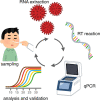Intensive diagnostic management of coronavirus disease 2019 (COVID-19) in academic settings in Japan: challenge and future
- PMID: 33062076
- PMCID: PMC7549085
- DOI: 10.1186/s41232-020-00147-2
Intensive diagnostic management of coronavirus disease 2019 (COVID-19) in academic settings in Japan: challenge and future
Abstract
Coronavirus disease 2019 (COVID-19), caused by severe acute respiratory syndrome coronavirus 2 (SARS-CoV-2), first emerged in Wuhan, China, and has spread globally to most countries. In Japan, the first COVID-19 patient was identified on January 15, 2020. By June 30, the total number of patients diagnosed with COVID-19 reached 18,000. The impact of molecular detection of pathogens is significant in acute-care settings where rapid and accurate diagnostic measures are critical for decisions in patient treatment and outcomes of infectious diseases. Polymerase chain reaction (PCR)-based methods, such as quantitative PCR (qPCR), are the most established gene amplification tools and have a comprehensive range of clinical applications, including detecting a variety of pathogens, even novel agents causing emerging infections. Because SARS-CoV-2 contains a single-stranded RNA genome, reverse-transcription qPCR (RT-qPCR) has been broadly employed for rapid and sensitive quantitative measurements of viral RNA copy numbers. The RT-qPCR method, however, still requires time-consuming reactions with two different enzymes in addition to isolation of RNA from patient samples, limiting the numbers of testing institutions for diagnosing SARS-CoV-2 infection. Japan is known to have performed a relatively small number of PCR tests as well as confirmed cases among developed nations; as of June 30, 2020, approximately 390,000 people in Japan had undergone PCR tests. Given the devastating impact on medical services and the scale of demand for diagnostic testing of COVID-19, it has been proposed that academic settings such as basic research departments in university/college can be engaged in diagnosing, especially in university hospitals or academic medical centers. In collaboration with established diagnostic laboratories, academic facilities can divert their function to detecting virus from patients with suspected COVID-19, adopting existing specialized expertise in virus handling, molecular work, and data analysis. This in-house testing strategy facilitates the rapid diagnosing of thousands of samples per day and reduces sample turnaround time from 1 week to less than 24 h. This review provides an overview of the general principles, diagnostic value, and limitations of COVID-19 diagnosis platforms in Japan, in particular in-house testing at academic settings.
Keywords: COVID-19; Diagnosis; PCR; SARS-CoV-2; Virus.
© The Author(s) 2020.
Conflict of interest statement
Competing interestsThere is no competing interest to declare.
Figures


Similar articles
-
Development and Clinical Application of a Rapid and Sensitive Loop-Mediated Isothermal Amplification Test for SARS-CoV-2 Infection.mSphere. 2020 Aug 26;5(4):e00808-20. doi: 10.1128/mSphere.00808-20. mSphere. 2020. PMID: 32848011 Free PMC article.
-
Safety and Efficacy of Imatinib for Hospitalized Adults with COVID-19: A structured summary of a study protocol for a randomised controlled trial.Trials. 2020 Oct 28;21(1):897. doi: 10.1186/s13063-020-04819-9. Trials. 2020. PMID: 33115543 Free PMC article.
-
Modelling of hypothetical SARS-CoV-2 point-of-care tests on admission to hospital from A&E: rapid cost-effectiveness analysis.Health Technol Assess. 2021 Mar;25(21):1-68. doi: 10.3310/hta25210. Health Technol Assess. 2021. PMID: 33764295 Free PMC article.
-
Thoracic imaging tests for the diagnosis of COVID-19.Cochrane Database Syst Rev. 2020 Sep 30;9:CD013639. doi: 10.1002/14651858.CD013639.pub2. Cochrane Database Syst Rev. 2020. Update in: Cochrane Database Syst Rev. 2020 Nov 26;11:CD013639. doi: 10.1002/14651858.CD013639.pub3. PMID: 32997361 Updated.
-
Effectiveness of tests to detect the presence of SARS-CoV-2 virus, and antibodies to SARS-CoV-2, to inform COVID-19 diagnosis: a rapid systematic review.BMJ Evid Based Med. 2022 Feb;27(1):33-45. doi: 10.1136/bmjebm-2020-111511. Epub 2020 Oct 1. BMJ Evid Based Med. 2022. PMID: 33004426
Cited by
-
A Rapid Detection of COVID-19 Viral RNA in Human Saliva Using Electrical Double Layer-Gated Field-Effect Transistor-Based Biosensors.Adv Mater Technol. 2022 Jan;7(1):2100842. doi: 10.1002/admt.202100842. Epub 2021 Sep 12. Adv Mater Technol. 2022. PMID: 34901383 Free PMC article.
-
Using a Systems Engineering Approach to Build a PCR Testing System at a Medical School During the COVID-19 Pandemic.Risk Manag Healthc Policy. 2024 Mar 21;17:649-662. doi: 10.2147/RMHP.S441618. eCollection 2024. Risk Manag Healthc Policy. 2024. PMID: 38528942 Free PMC article.
References
-
- Gerberding JL. Faster . . . but fast enough? Responding to the epidemic of severe acute respiratory syndrome. N Engl J Med. 2003;348:2030-2031. - PubMed
Publication types
LinkOut - more resources
Full Text Sources
Miscellaneous

